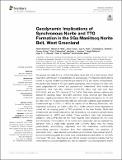Files in this item
Geodynamic implications of synchronous Norite and TTG formation in the 3 Ga Maniitsoq Norite Belt, West Greenland
Item metadata
| dc.contributor.author | Waterton, Pedro | |
| dc.contributor.author | Hyde, William | |
| dc.contributor.author | Tusch, Jonas | |
| dc.contributor.author | Hollis, Julie | |
| dc.contributor.author | Kirkland, Christopher | |
| dc.contributor.author | Kinney, Carson | |
| dc.contributor.author | Yakymchuk, Chris | |
| dc.contributor.author | Gardiner, Nicholas | |
| dc.contributor.author | Zakharov, David | |
| dc.contributor.author | Olierook, Hugo | |
| dc.contributor.author | Münker, Carsten | |
| dc.contributor.author | Lightfoot, Peter | |
| dc.contributor.author | Szilas, Kristoffer | |
| dc.date.accessioned | 2020-10-08T11:30:04Z | |
| dc.date.available | 2020-10-08T11:30:04Z | |
| dc.date.issued | 2020-09-22 | |
| dc.identifier | 270618526 | |
| dc.identifier | 9ba49a02-7306-4f36-b450-12c6abfaef27 | |
| dc.identifier | 85092050888 | |
| dc.identifier | 000619871400001 | |
| dc.identifier.citation | Waterton , P , Hyde , W , Tusch , J , Hollis , J , Kirkland , C , Kinney , C , Yakymchuk , C , Gardiner , N , Zakharov , D , Olierook , H , Münker , C , Lightfoot , P & Szilas , K 2020 , ' Geodynamic implications of synchronous Norite and TTG formation in the 3 Ga Maniitsoq Norite Belt, West Greenland ' , Frontiers in Earth Science , vol. 8 , 562062 . https://doi.org/10.3389/feart.2020.562062 | en |
| dc.identifier.issn | 2296-6463 | |
| dc.identifier.other | Bibtex: 10.3389/feart.2020.562062 | |
| dc.identifier.other | ORCID: /0000-0003-3465-9295/work/81798018 | |
| dc.identifier.uri | https://hdl.handle.net/10023/20744 | |
| dc.description | This study was supported by Villum Fonden through grant VKR18978 to K.S. Funding for article fees was supplied by the Ministry of Mineral Resources, Government of Greenland. | en |
| dc.description.abstract | We present new data for the ∼3.0 Ga Maniitsoq Norite Belt of the Akia Terrane, West Greenland, with the aim of understanding its petrogenesis. The Maniitsoq Norite Belt is hosted in regional tonalite-trondhjemite-granodiorite (TTG) and dioritic orthogneisses, intruded by later sheets of TTG and granite pegmatites, and comprises two main rock types: plagioclase-rich “norites” and pyroxene-rich “melanorites”. Both norites and melanorites have high SiO2 contents (52–60 wt% SiO2), high bulk rock Mg# (0.57–0.83), and low TiO2 contents (0.1–0.7 wt%). Their trace element patterns are defined by depleted heavy Rare-Earth elements, highly enriched light Rare-Earth elements, negative anomalies in Nb, Ta, and Ti, and variable anomalies in Zr, Hf, and Eu. New zircon U-Pb geochronology data and previously published ages establish an emplacement age of 3,013 ± 1 Ma for the majority of the Maniitsoq Norite Belt, with magmatism continuing until 3,001 ± 3 Ma. This ∼12 Myr period of norite magmatism is coeval with an ongoing period of TTG production in the Akia Terrane. Norite Belt emplacement was closely followed by high temperature, low pressure granulite-facies metamorphism at ∼800°C and 900°C/GPa) and that the norite magmas were emplaced into thin crust and lithosphere. Compositions of the norites and melanorites can be explained by derivation from a single mafic parental melt (∼13 wt% MgO), with the norites predominantly accumulating plagioclase and the melanorites predominantly accumulating pyroxene. Evidence from field relationships, the presence of xenocrystic zircon, major element compositions and combined trace element and Hf-isotope modelling suggests the norites were contaminated by assimilation of ∼20–30% continental TTG crust. Geochemical and Hf-Nd isotopic constraints indicate that the norite mantle source was depleted, and that this depletion occurred significantly before the emplacement of the norite magmas. Contemporaneous production of both TTGs and norite, their emplacement in thin crust, and the rapid transition to high temperature, low pressure granulite-facies metamorphism is best explained by their formation in an ultra-hot orogeny. Formation of norites in this setting may be restricted to >2.7 Ga, when geothermal gradients were higher on Earth. | |
| dc.format.extent | 30 | |
| dc.format.extent | 8064273 | |
| dc.language.iso | eng | |
| dc.relation.ispartof | Frontiers in Earth Science | en |
| dc.subject | Norite | en |
| dc.subject | Crustal contamination | en |
| dc.subject | Tonalite-trondhjemite-granodiorite and tonalite-trondhjemite-granodiorite-like gneisses | en |
| dc.subject | Nd isotope | en |
| dc.subject | Hf isotope | en |
| dc.subject | Zircon U-Pb dating | en |
| dc.subject | Granulite and amphibolite facies | en |
| dc.subject | Ultra-hot orogen | en |
| dc.subject | GE Environmental Sciences | en |
| dc.subject | DAS | en |
| dc.subject.lcc | GE | en |
| dc.title | Geodynamic implications of synchronous Norite and TTG formation in the 3 Ga Maniitsoq Norite Belt, West Greenland | en |
| dc.type | Journal article | en |
| dc.contributor.institution | University of St Andrews. School of Earth & Environmental Sciences | en |
| dc.identifier.doi | 10.3389/feart.2020.562062 | |
| dc.description.status | Peer reviewed | en |
This item appears in the following Collection(s)
Items in the St Andrews Research Repository are protected by copyright, with all rights reserved, unless otherwise indicated.

